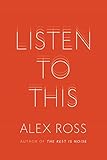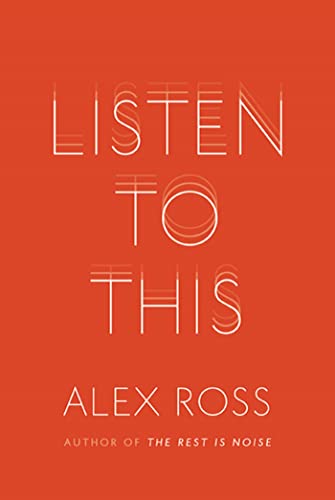
 Near the end of Listen to This , his newest collection of essays, Alex Ross quotes the philosopher John Dewey in his 1934 treatise, Art as Experience: “When an art product once attains classic status, it somehow becomes isolated from the human conditions under which it was brought into being and from the human consequences it engenders in actual life experience.” It would be near impossible for Ross’s readers to be as well-versed as he is in classical tradition—it takes a well-schooled listener to distinguish one opus from another, a chacona from a zarabanda. But Ross has established himself as one of today’s most valuable cultural critics for one particular reason: he can not only show you the qualities of music, but makes you understand why the qualities matter. He makes believers out of know-nothings.
Near the end of Listen to This , his newest collection of essays, Alex Ross quotes the philosopher John Dewey in his 1934 treatise, Art as Experience: “When an art product once attains classic status, it somehow becomes isolated from the human conditions under which it was brought into being and from the human consequences it engenders in actual life experience.” It would be near impossible for Ross’s readers to be as well-versed as he is in classical tradition—it takes a well-schooled listener to distinguish one opus from another, a chacona from a zarabanda. But Ross has established himself as one of today’s most valuable cultural critics for one particular reason: he can not only show you the qualities of music, but makes you understand why the qualities matter. He makes believers out of know-nothings.
In Ross’s book, a collection of work published in The New Yorker, he brings the same characteristic clarity and enthusiasm that made his first book, The Rest is Noise, such a runaway success: Ross writes from an informed yet never didactic perspective, even when he is giving his take on modern recording technology’s effect on the way we experience music. He says “Music is no longer something we do ourselves, or even watch other people do in front of us. It has become a radically virtual medium, an art without a face.” Ross’s major passion, as both a critic and fan, is to bridge the gap between how we talk about music and how we feel about music.
When Ross writes about classical music, you can tell he knows his stuff: try to find another music critic working today who was steeped in Berlioz before he discovered the Beatles. But perhaps Ross gained an unusual advantage by coming late to the pop music game: he writes about all genres with a consistent and thorough approach to each genre’s structure and theory. His essay on Björk, compares a piece of music she’d written at the age of 15 with the beginning of the second part of The Rite of Spring. (One can only imagine what his treatise on post-breakdown Brittany Spears might read like.) And his take on Bob Dylan in “I Saw the Light” isn’t so much an actual study of Dylan as it is a take on how the rest of the world is trying to pin him down. Ross rails against the marginalization of classical music as a dead and unpopular art form, and he plays defense against accusations of classical music being arty and too, well, classy for pleasure listening.
Every music fan, classical or contemporary, will find something to savor in this collection. Among Ross’s subjects are Mozart’s struggle to find emotional balance in his work and his personal life; attempts to revitalize the Los Angeles Philharmonic audience, and the emergence of Western classical music fans in China. His brief portraits of Cobain and Sinatra are fun, but it’s John Luther Adams and the St. Lawrence Quartet who get the rock-star treatment. (He may also make the New York cabaret act Kiki and Herb the hottest ticket in town.) His essay on Radiohead could sit with the best of Rolling Stone’s think-pieces, except Ross has the ear for the band’s classical roots. “The doubling of the theme, a very Led Zeppelin move, has thunderous logic, as if an equation had been solved. The interplay was as engaging to the mind as anything that had been done in classical music recently, but you could jump and down to it.”
The one previously unpublished essay, and the highlight of the book, will blow the minds of even the best-read music aficionados. “Chacona, Lamento, Walking Blues” is Ross’s study of the basso lamento, a repeating bass line meant to represent sorrow across multiple styles of music, from the earliest flamenco melodies to modern-day blue riffs. (He points the reader to both Bach’s 1714 cantata “Weinen, Klagen, Sorgen, Zagen” and Skip James’s “Devil Got My Woman” as viable examples of this weepy progression.). He traces this melodic marker not only as a strand of sonic DNA across different genres, but as a narrative device that marks storytelling from different kinds of musical authors. (The book’s illustrative playlist is available on iTunes for $20.00, or you can go to the book’s website to sample mentioned songs for free.) It would be a shame to read Ross’s criticism without your headphones on: his description of Marian Anderson’s voice is lush and accurate—“caressing little slides from note to note and a delicately trembling tone adding human warmth”—, but one has to listen to the recording to get the full effect. His affection or derision is so perfectly pitched, you want to run to your radio, your iPod, whatever source you prefer, to share in his enthusiasm.
Ross can make you hear his interviewees as well as their music: the laugh of the pianist Michiko Uchida (“wildly oscillating . . . like a flock of songbirds ready to be transcribed by Olivier Messiaen.”) He gives life to the most wooden of composers—who knew the instability of Schubert’s personal life could explain the way his compositions fluctuated between the light and beautiful and the harmonically violent? But it’s in his chapter on the crisis in music education, “Learning the Score,” that the real thrust of Ross’s argument emerges. His time at the Malcolm X Shabazz High School in Newark, New Jersey is an impassioned defense for music in elementary education. It only takes a few lines of Ross’s description of a child tentatively approaching a piano and churning out his own West End variation on Beethoven’s Fur Elise, juxtaposed with the ever-increasing cuts in the availability of such opportunities, to see the vulnerable future ahead for classical music.
Real music appreciation, whether it comes to us through nuanced research or infused criticism, is not easy to find. Ross sees audiences falling into a rut: we repeat the classics over and over, canonizing them and crippling their ability to move us. He fears the increasing sterility of music: “Celebrity maestros and virtuosos assumed ersatz creative roles, lending a patina of novelty to superfamiliar music. Living composers became curiosities and nuisances. Almost nothing about the enterprise had any tangible connection to contemporary life.” Yet in Ross, we have heard one wildly entertaining basso lamento that bemoans, and celebrates, the qualities of great art.



